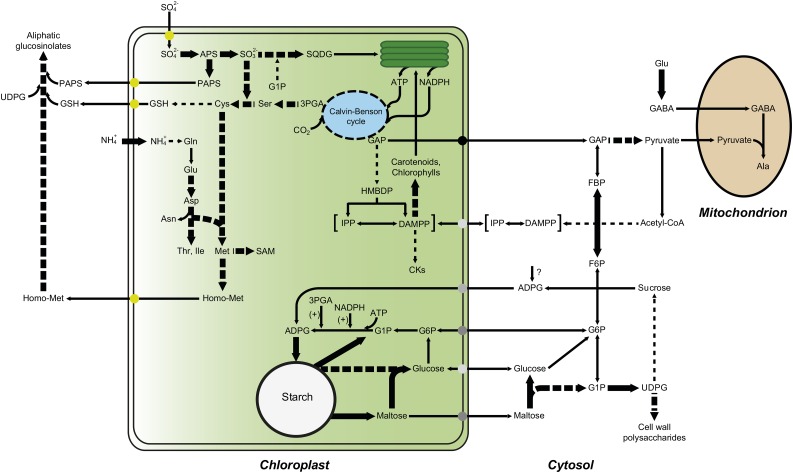Figure 6.
Scheme illustrating the metabolic adjustment that occurs in leaves of pgi1-2 plants in response to A. alternata VC exposure. The VC-promoted up-regulation of PSII reaction center proteins and enzymes involved in the synthesis of sulfolipid and photosynthetic pigments results in enhanced photosynthetic activity. The resulting augmentation of GAP fuels the production of MEP-derived compounds, such as photosynthetic pigments and plastidic CKs, which initiate a cascade of reactions that cause various responses, such as the production of proteins involved in photoprotection, cell wall production and modification, and amino acid biosynthesis (Sánchez-López et al., 2016). Gln is metabolized to Glu, Asp, Asn, Met, and aliphatic glucosinolates. Also, cytosolic Glu is metabolized to Ala through the γ-aminobutyrate (GABA) shunt. According to this model, VC-promoted starch overaccumulation in pgi1-2 leaves is the consequence of the stimulation of starch biosynthetic pathways that bypass pPGI through the transport of cytosolic hexoses (e.g. Glc and/or Glc-6-P) and/or ADP-Glc (ADPG) into the chloroplast. The high levels of 3PGA and NADPH resulting from VC-enhanced photosynthesis activate AGP (Li et al., 2011), which, in turn, facilitates the synthesis of starch. VCs also increase the expression of starch breakdown enzymes to prevent the excessive accumulation of starch and establish a starch substrate cycle. Starch breakdown products can be exported to the cytosol for their subsequent conversion into UDP-Glc, which is necessary for the synthesis of Suc and/or cell wall polysaccharides. Enzymes that are up-regulated by VCs are indicated with thick arrows. Multistep reactions are depicted with dashed arrows.

